Given a piece of physical metal letterpress printing type (or ancillary material such as metal printers' furniture, leading, etc.) there are two questions of identification which may be asked about the type itself: who cast it, and how (on what machine) was it cast? Several physical features and markings of types may help in this identification.
Caution: In these Notebooks the reader will continually encounter statements concerning exceptions. In over five centuries of hand and machine typefounding, there is little which hasn't been tried. This should serve as a constant warning against general claims.
These Notebooks may (or may not) be useful, but that doesn't really matter. To me they are in large part really a celebration of the three-dimensional physicality and sculptural beauty of type itself. The great English typographer (in Moxon's full sense of the term) Harry Carter said famously that
"Type is something that you can pick up and hold in your hand."
He was speaking, in 1968, to an audience of bibliographers who had forgotten this, but now there are two generations of people who call themselves "typographers" who may never have seen actual type at all. As an antidote to this, I commend to you James Mosley's article "Type Held in the Hand." (2012)
(See also the Notebook on Dimensions and Features of Type in the Making Printing Matrices and Types set of Notebooks.)
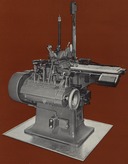
Types Made by Specific Machines
Some of the type casting machines developed in the 20th century either left distinctive non-printing features on the types they cast or cast types of distinctive form (internally and externally).
All of the individual features shown in this Notebook in the context of specific casters will also be discussed below in their respective sections.
Types Made using Specific Matrices
[NOT DONE] For the most part, the style of matrix employed by the type founder is not distinguishable on the type or to the printer, but there are exceptions. Ludlow matrices, when cast on type casting machines, produce unique marks on the Body; the types cast from italic Ludlow matrices are even more distinctive. With both Ludlow and Linotype-compatible matrices, logotypes may be cast from assembled matrices.

Distinctive Type Bodies
[ONLY PARTLY DONE] Cored bodies (Lanston Monotype Giant Caster and others). Externally relieved bodies (Barnhart Brothers & Spindler, Monotype Super Caster). ATF "Wing Bodies." Super Caster Palace Script bodies. Slanted bodies. Beveled shoulders (Inland Type Foundry, Monotype Super Caster).
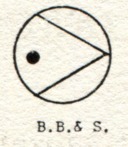
Pin Marks
Photographs and images by Richard L. Hopkins, Stephen O. Saxe, Jens Jørgen Hansen, Robert A. Mullen, Nick Sherman, Lars Schwarz, et. al. John S. Carroll's 1961 booklet. Herb Harnish's 1977 booklet. Bibliography and references to other sources.
(At present, this is by far the largest of these Notebooks.)
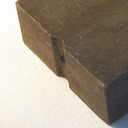
The Groove
"Ordinary" grooves. No groove (Monotype Composition Caster, Lanston Monotype Giant Caster, Monotype Super Caster). Offset groove (Thompson Type-Caster, Side-Jet).
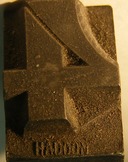
Marks and Textures of the Shoulder
The Shoulder and the Counters of types often have markings cast into them (trade marks, piece identifiers, etc.)
[NOT DONE] Also, the matrices electroformed by Andrew Dunker leave a distinctive pattern of parallel lines on the shoulders of types cast from them.
For geometrical variations of the Shoulder see Distinctive Type Bodies, above.
For non-printing ornamented or trade-marked surfaces of quads and spaces, see Quads and Spaces, below.
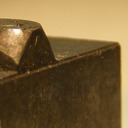
Features of the Beard
The reader of (letterpress-)printed material never sees the Beard of the type, but the typefounder looks at it more than any other part of the type.

Elevations Above the Shoulder
Typically the Counters are not made to as deep a depth-of-drive as the Shoulder. Often, additionally, there are elevated portions of the Shoulder which (probably) reinforce the Beard (and make the matrix maker's job easier). Usually these are made at the same level as the Counter, as distinct areas. Sometimes, however, they will rise gradually. At other times there may not even be a single Counter level.

Linecaster Material
[NOT DONE] Distinguishing the printing materials produced by the Linotype, Intertype, Ludlow, and "All-Purpose Linotype." [I have no Nebitype material to show.]

Strip Material and Slugs
[NOT DONE] Distinguishing true continuous-cast Elrod material from fusion-cast Monotype material. Monotype ornamental capabilities vs. Elrod linear capabilities. Rule. Brass Rule. Steel Cutting Rule. Base. Linecaster-cast vs. other slugs.

Metal Printers' Furniture
[NOT DONE] Primarily in lead and steel. (Show it in wood, and show reglet, for comparison.) Distinguish furniture from base.

Other Things You Find in the Chase
[NOT DONE] Numbering machines. Hole punches.

Curiosities of Type
[NOT DONE] Square types cut from Elrod strip material.

Unidentified Items
[NONE YET - which by no means implies that I've identified everything!]
All portions of this document not noted otherwise are Copyright © 2014 by David M. MacMillan and Rollande Krandall.
Circuitous Root is a Registered Trademark of David M. MacMillan and Rollande Krandall.
This work is licensed under the Creative Commons "Attribution - ShareAlike" license. See http://creativecommons.org/licenses/by-sa/3.0/ for its terms.
Presented originally by Circuitous Root®